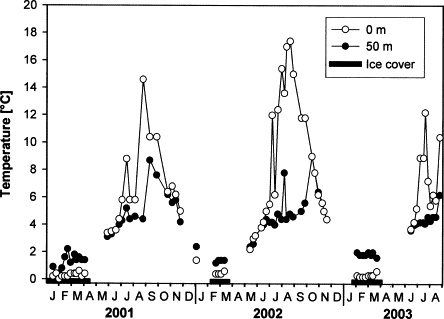 Three years of regular weekly/biweekly monitoring of seasonal changes in temperature, transparency, chlorophyll a (CHL) and bacteria [erythrosine-stained microscopic counts and cultivable colony forming units (CFUs)] at the vertical profile in the South basin of Lake Baikal (51°54′195″N, 105°04′235″E, depth 800 m) were evaluated. In more detail, the structure and function of phytoplankton and the microbial loop in the euphotic layer at the same site were investigated during the late-winter–early-spring period under the ice. The depth of euphotic zone (up to 1% of surface irradiation) was 35 to 40 m. Primary production was measured three times a week with the 14C method in 2, 10, 20, 30 and 40 m. Maximum production was found in 10 m, with lower values towards the surface (light inhibition) and towards the lower layers. The total production in cells larger than 1 μm in the column (0–40 m) was 204–240 mg C d−1 m−2, 30–40% of it being in cells 1–3 μm (mostly picocyanobacteria), which represented roughly 9% of the total chlorophyll a (estimated from pigment analyses). A major part of phytoplankton biomass was formed by diatoms (Synedra acus Hust., Asterionella formosa Hass. and Stephanodiscus meyerii Genkal & Popovskaya). Total production (including extracellular, dissolved organic matter) was 235–387 mg C day−1 m−2, and the exudates were readily used by bacteria (particles 0.2–1 μm). This part amounted to 1–5% of cellular production in 2 to 20 m and 11–77% of cellular production in 20–40 m, i.e., in light-limited layers. From 0 to 30 m, chlorophyll a concentration was 0.8 to 1.3 μg l−1, wherefrom it decreased rapidly to 0.1 μg l−1 towards the depth of 40 m. Bacteria (DAPI-stained microscopic counts) reached 0.5–1.4×106 ml−1; their cell volumes measured via image analysis were small (average 0.05 μm−3), often not well countable when erythrosine stain was used. Bacterial biomasses were in the range of 6–21 μg C l−1. Numbers of colony forming units (CFUs) on nutrient fish-agar were c. 3–4 orders lower than DAPI counts. The amounts of heterotrophic protists were low, whereby flagellates reached 6 to 87 ml−1 and ciliates, 0.2–1.2 ml−1 (mostly Oligotrichida). Bacterial production was measured in the same depths as primary production using 3H-thymidine (Thy) and 14C-leucine (Leu) uptake. Consistently, bacterial abundances, biomasses, thymidine and leucine production were higher by 30–50% in layers 2, 10 and 20 m compared with that in the deeper 30 and 40 m, where cellular primary production was negligible. Leucine uptake in the deeper layers was even three times lower than in the upper ones. From the comparison of primary and bacterial production, bacteria roughly use 20–40% of primary production during 24 h in the layers 2 to 20 m.
Three years of regular weekly/biweekly monitoring of seasonal changes in temperature, transparency, chlorophyll a (CHL) and bacteria [erythrosine-stained microscopic counts and cultivable colony forming units (CFUs)] at the vertical profile in the South basin of Lake Baikal (51°54′195″N, 105°04′235″E, depth 800 m) were evaluated. In more detail, the structure and function of phytoplankton and the microbial loop in the euphotic layer at the same site were investigated during the late-winter–early-spring period under the ice. The depth of euphotic zone (up to 1% of surface irradiation) was 35 to 40 m. Primary production was measured three times a week with the 14C method in 2, 10, 20, 30 and 40 m. Maximum production was found in 10 m, with lower values towards the surface (light inhibition) and towards the lower layers. The total production in cells larger than 1 μm in the column (0–40 m) was 204–240 mg C d−1 m−2, 30–40% of it being in cells 1–3 μm (mostly picocyanobacteria), which represented roughly 9% of the total chlorophyll a (estimated from pigment analyses). A major part of phytoplankton biomass was formed by diatoms (Synedra acus Hust., Asterionella formosa Hass. and Stephanodiscus meyerii Genkal & Popovskaya). Total production (including extracellular, dissolved organic matter) was 235–387 mg C day−1 m−2, and the exudates were readily used by bacteria (particles 0.2–1 μm). This part amounted to 1–5% of cellular production in 2 to 20 m and 11–77% of cellular production in 20–40 m, i.e., in light-limited layers. From 0 to 30 m, chlorophyll a concentration was 0.8 to 1.3 μg l−1, wherefrom it decreased rapidly to 0.1 μg l−1 towards the depth of 40 m. Bacteria (DAPI-stained microscopic counts) reached 0.5–1.4×106 ml−1; their cell volumes measured via image analysis were small (average 0.05 μm−3), often not well countable when erythrosine stain was used. Bacterial biomasses were in the range of 6–21 μg C l−1. Numbers of colony forming units (CFUs) on nutrient fish-agar were c. 3–4 orders lower than DAPI counts. The amounts of heterotrophic protists were low, whereby flagellates reached 6 to 87 ml−1 and ciliates, 0.2–1.2 ml−1 (mostly Oligotrichida). Bacterial production was measured in the same depths as primary production using 3H-thymidine (Thy) and 14C-leucine (Leu) uptake. Consistently, bacterial abundances, biomasses, thymidine and leucine production were higher by 30–50% in layers 2, 10 and 20 m compared with that in the deeper 30 and 40 m, where cellular primary production was negligible. Leucine uptake in the deeper layers was even three times lower than in the upper ones. From the comparison of primary and bacterial production, bacteria roughly use 20–40% of primary production during 24 h in the layers 2 to 20 m.
Keywords: bacteria; bacterial production; pelagial; phytoplankton; primary production
